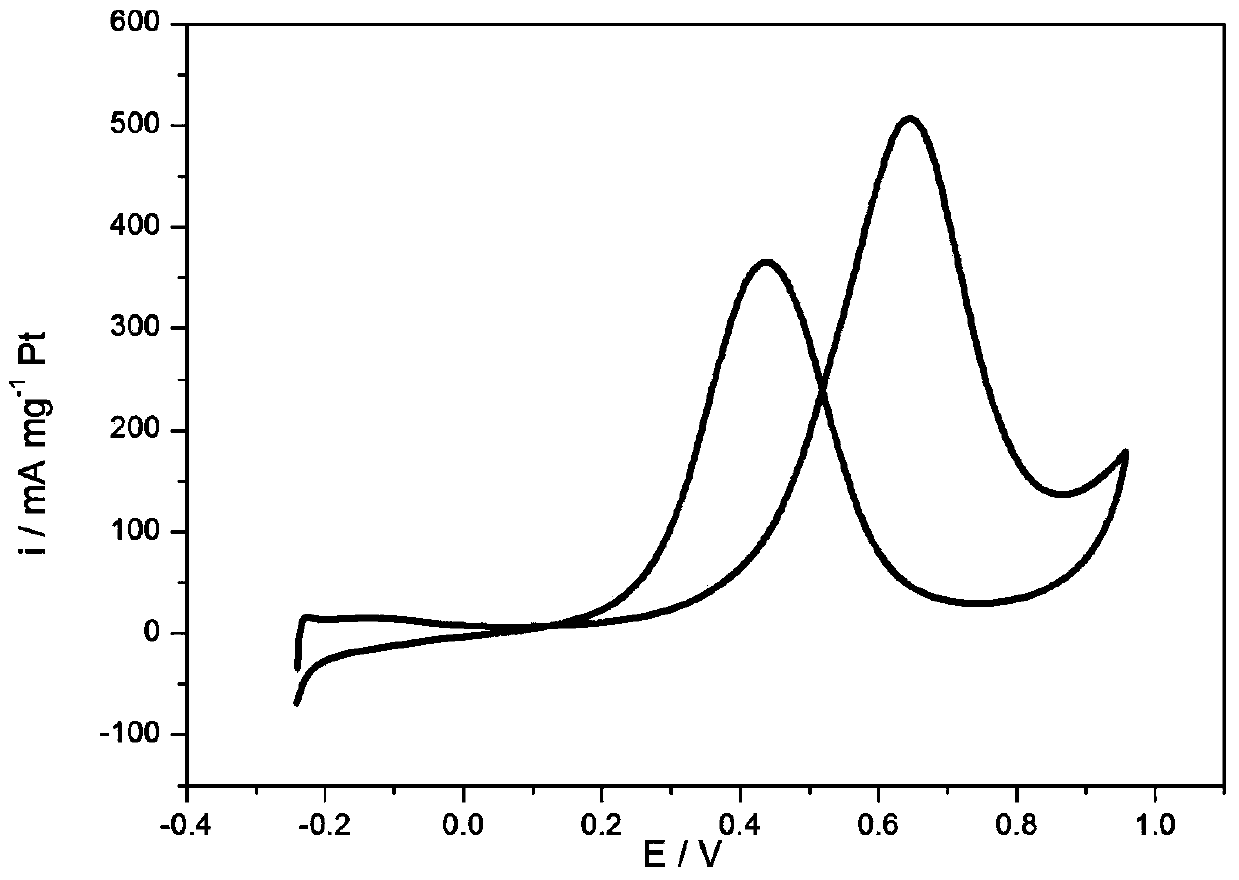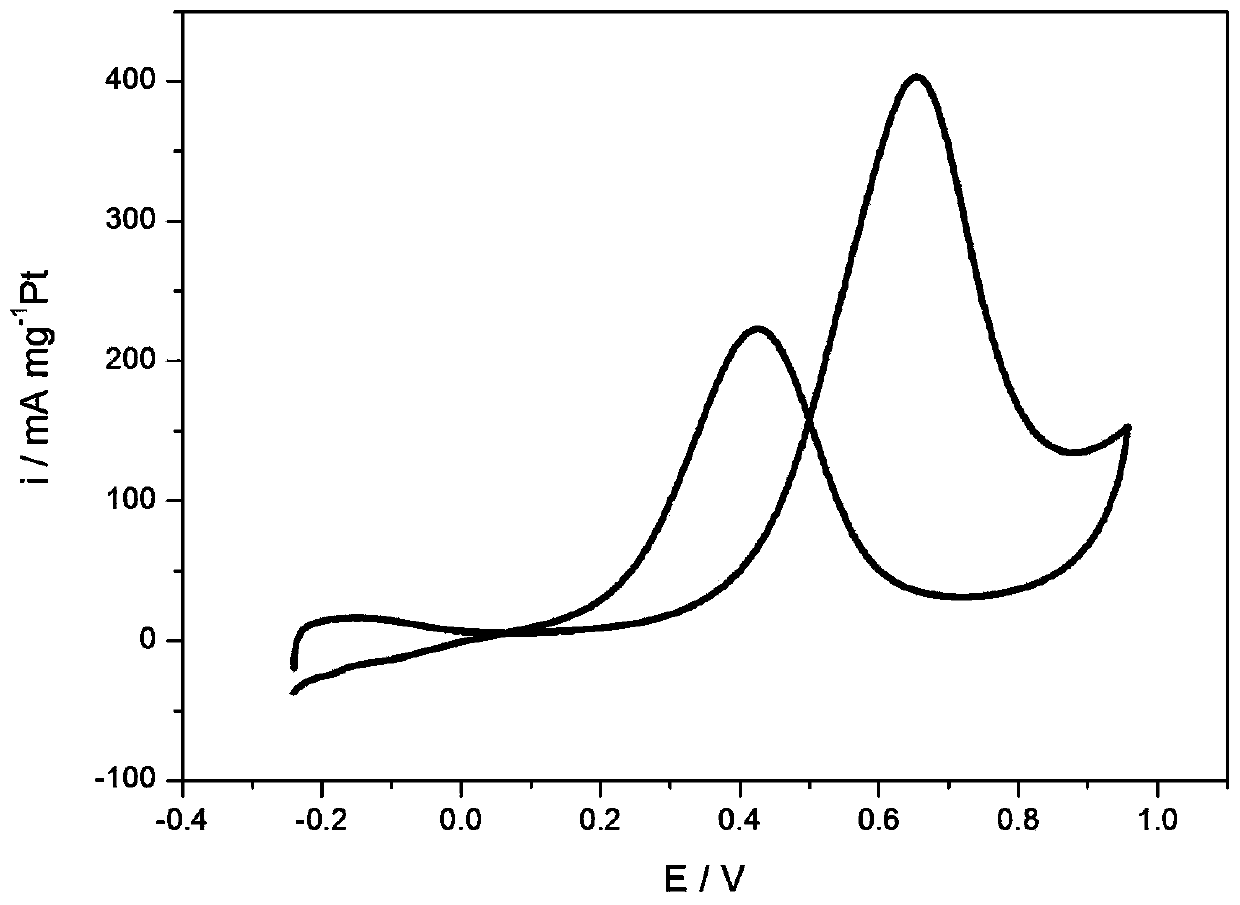Post-processing method for carbon-supported Pt-Fe catalyst
A catalyst and carbon-supported technology, applied in chemical instruments and methods, catalyst activation/preparation, physical/chemical process catalysts, etc., can solve problems such as complex methods and harsh conditions, achieve simple methods, improve catalytic oxidation, and overcome stability Sexually low effect
- Summary
- Abstract
- Description
- Claims
- Application Information
AI Technical Summary
Problems solved by technology
Method used
Image
Examples
Embodiment 1
[0044] 1) FeCl 3 、H 2 PtCl 6 and VulcanXC-72 are uniformly dispersed in the aqueous solution, and the substances contained in it are prepared according to the mass ratio of Fe:Pt:C=10:10:80 to prepare a mixed suspension, and mix well;
[0045] 2) Place the suspension in 1) in a water bath at 50°C, evaporate the solvent to dryness, and obtain a black powder;
[0046] 3) Put 2) the black powder in H 2 / N 2 (10%H 2 ) in a tube furnace at 500°C for 3 hours to obtain the original PtFe / C catalyst;
[0047]4) soak 3) the original PtFe catalyst in 0.5molL -1 In the sulfuric acid solution, keep at 80°C, and magnetically stir for 24 hours to obtain a black suspension;
[0048] 5) Cool the black suspension described in 4) to room temperature, suction filter, wash, and vacuum-dry at 80° C. for 8 hours to obtain a chemically dealloyed PtFe / C catalyst.
[0049] Add 5 mg of the above-mentioned chemical dealloying PtFe / C catalyst to 50 μL of the Nafion solution produced by Ladrich wit...
Embodiment 2
[0051] 1) FeCl 3 、H 2 PtCl 6 and VulcanXC-72 are uniformly dispersed in the aqueous solution, and the substances contained in it are prepared according to the ratio of mass ratio Fe:Pt:C=13:7:80 to prepare a mixed suspension, and mix well;
[0052] 2) Place the suspension in 1) in a water bath at 50°C, evaporate the solvent to dryness, and obtain a black powder;
[0053] 3) Put 2) the black powder in H 2 / N 2 (10%H 2 ) in a tube furnace at 500°C for 3 hours to obtain the original PtFe / C catalyst;
[0054] 4) soak 3) the original PtFe catalyst in 0.5molL -1 In the sulfuric acid solution, keep at 80°C, and magnetically stir for 24 hours to obtain a black suspension;
[0055] 5) Cool the black suspension described in 4) to room temperature, suction filter, wash, and vacuum-dry at 80° C. for 8 hours to obtain a chemically dealloyed PtFe / C catalyst.
[0056] Add 5 mg of the above-mentioned chemical dealloying PtFe / C catalyst to 50 μL of the Nafion solution produced by Ladri...
Embodiment 3
[0058] 1) FeCl 3 、H 2 PtCl 6 and VulcanXC-72 are evenly dispersed in the aqueous solution, and the substances contained in it are prepared according to the mass ratio of Fe:Pt:C=15:5:80 to prepare a mixed suspension, and mix well;
[0059] 2) Place the suspension in 1) in a water bath at 50°C, evaporate the solvent to dryness, and obtain a black powder;
[0060] 3) Put 2) the black powder in H 2 / N 2 (10%H 2 ) in a tube furnace at 500°C for 3 hours to obtain the original PtFe / C catalyst;
[0061] 4) soak 3) the original PtFe catalyst in 0.5molL -1 In the sulfuric acid solution, keep at 80°C, and magnetically stir for 24 hours to obtain a black suspension;
[0062] 5) Cool the black suspension described in 4) to room temperature, suction filter, wash, and vacuum-dry at 80° C. for 8 hours to obtain a chemically dealloyed PtFe / C catalyst.
[0063] Add 5 mg of the above-mentioned chemical dealloying PtFe / C catalyst to 50 μL of the Nafion solution produced by Ladrich with a...
PUM
| Property | Measurement | Unit |
|---|---|---|
| The average particle size | aaaaa | aaaaa |
Abstract
Description
Claims
Application Information
 Login to View More
Login to View More - R&D
- Intellectual Property
- Life Sciences
- Materials
- Tech Scout
- Unparalleled Data Quality
- Higher Quality Content
- 60% Fewer Hallucinations
Browse by: Latest US Patents, China's latest patents, Technical Efficacy Thesaurus, Application Domain, Technology Topic, Popular Technical Reports.
© 2025 PatSnap. All rights reserved.Legal|Privacy policy|Modern Slavery Act Transparency Statement|Sitemap|About US| Contact US: help@patsnap.com



